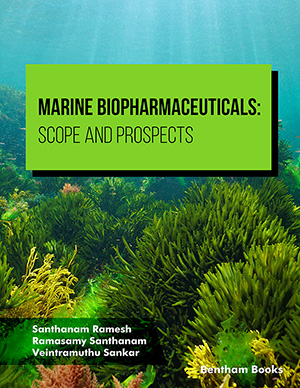Abstract
Poly (ADP-ribose) polymerase (PARP) acts as an essential DNA repair enzyme. PARP inhibitors are novel small molecule targeted drugs based on the principle of "Synthetic Lethality", which affect DNA repair process by competitively inhibiting the activity of PARP enzyme and thereby kill cancer cells. Currently, four PARP inhibitors including olaparib, rucaparib, niraparib, and talazoparib have been approved by FDA for cancer treatment and have achieved great success in the treatment of ovarian cancer, breast cancer, and pancreatic cancer, etc. This paper provides a general overview of the research progress of PARP inhibitors including the major structure types, structure-activity relationship (SAR), and synthetic routes, with the aim of providing ideas for the discovery and synthesis of novel PARP inhibitors.
Keywords: Ovarian cancer, synthetic lethality, PARP inhibitors, olaparib, structure-activity relationship, phthalazinones, synthesis.
[http://dx.doi.org/10.2174/092986712802002464] [PMID: 22788767]
[http://dx.doi.org/10.1158/1078-0432.CCR-10-0984] [PMID: 20823148]
[http://dx.doi.org/10.1016/0006-291X(63)90024-X] [PMID: 14019961]
[http://dx.doi.org/10.2174/15680266113136660209] [PMID: 24171773]
[http://dx.doi.org/10.2174/1568026614666140929115831] [PMID: 25262803]
[http://dx.doi.org/10.1155/2008/754190] [PMID: 19415146]
[http://dx.doi.org/10.1126/science.aam7344] [PMID: 28302823]
[http://dx.doi.org/10.1042/BST20180418] [PMID: 30420415]
[http://dx.doi.org/10.1186/1477-5956-8-22] [PMID: 20388209]
[http://dx.doi.org/10.3389/fonc.2013.00279] [PMID: 24294592]
[http://dx.doi.org/10.1186/1750-9378-8-46] [PMID: 24289880]
[http://dx.doi.org/10.1101/gad.291518.116] [PMID: 28202539]
[http://dx.doi.org/10.1038/s41467-018-05588-5] [PMID: 30104678]
[http://dx.doi.org/10.1093/nar/gkx1318] [PMID: 29361132]
[http://dx.doi.org/10.3390/biom2040635] [PMID: 24970153]
[http://dx.doi.org/10.1017/S146239940500904X] [PMID: 15836799]
[http://dx.doi.org/10.1038/nature03443] [PMID: 15829966]
[http://dx.doi.org/10.1038/nature03445] [PMID: 15829967]
[http://dx.doi.org/10.1056/NEJMoa1903387] [PMID: 31157963]
[http://dx.doi.org/10.1158/0008-5472.CAN-06-0140] [PMID: 16912188]
[http://dx.doi.org/10.1038/nrc1431] [PMID: 15343273]
[http://dx.doi.org/10.1042/BST20130187] [PMID: 24450632]
[http://dx.doi.org/10.1093/annonc/mdt384] [PMID: 24225019]
[http://dx.doi.org/10.1056/NEJMoa0900212] [PMID: 19553641]
[http://dx.doi.org/10.1021/acs.jmedchem.6b00055] [PMID: 27416328]
[http://dx.doi.org/10.1158/1535-7163.MCT-13-0803] [PMID: 24356813]
[http://dx.doi.org/10.1158/0008-5472.CAN-12-2753] [PMID: 23118055]
[http://dx.doi.org/10.1124/jpet.114.222448] [PMID: 25758918]
[http://dx.doi.org/10.1002/cmdc.201200109] [PMID: 22539490]
[http://dx.doi.org/10.1002/cmdc.201300120] [PMID: 23640754]
[http://dx.doi.org/10.1016/j.bmcl.2013.09.036] [PMID: 24120541]
[http://dx.doi.org/10.1515/hc-2017-0066]
[http://dx.doi.org/10.2174/1570193X15666181029130418]
[http://dx.doi.org/10.1016/j.mam.2013.01.006] [PMID: 23370117]
[http://dx.doi.org/10.1111/febs.12298] [PMID: 23601167]
[http://dx.doi.org/10.1016/j.bbcan.2014.07.004] [PMID: 25026313]
[http://dx.doi.org/10.1021/jm8001263] [PMID: 18800822]
[http://dx.doi.org/10.1021/jm020259n] [PMID: 12408707]
[http://dx.doi.org/10.1158/1535-7163.MCT-06-0552] [PMID: 17363489]
[http://dx.doi.org/10.1021/jm901188v] [PMID: 19873981]
[http://dx.doi.org/10.1021/jm5018237] [PMID: 25761096]
[http://dx.doi.org/10.1158/1078-0432.CCR-13-1391] [PMID: 23881923]
[http://dx.doi.org/10.1158/1078-0432.CCR-06-3039] [PMID: 17473206]
[http://dx.doi.org/10.1016/j.bmc.2008.05.044] [PMID: 18541433]
[http://dx.doi.org/10.1021/jm801171j] [PMID: 19143569]
[http://dx.doi.org/10.1016/j.bmcl.2013.06.055] [PMID: 23850199]
[http://dx.doi.org/10.1021/jm301825t] [PMID: 23473053]
[http://dx.doi.org/10.1021/acsmedchemlett.8b00569] [PMID: 30996792]
[http://dx.doi.org/10.1021/jm901775y] [PMID: 20337371]
[http://dx.doi.org/10.1016/j.canlet.2016.11.010] [PMID: 27847302]
[http://dx.doi.org/10.1200/jco.2011.29.15_suppl.1007]
[http://dx.doi.org/10.1158/1078-0432.CCR-11-2890] [PMID: 22291137]
[http://dx.doi.org/10.1016/S1470-2045(14)70228-1] [PMID: 24882434]
[http://dx.doi.org/10.1021/bi972383s] [PMID: 9521710]
[http://dx.doi.org/10.2174/1568026614666140929152123] [PMID: 25262797]
[http://dx.doi.org/10.1016/0005-2787(71)90012-8] [PMID: 4325158]
[http://dx.doi.org/10.1016/j.freeradbiomed.2009.04.008] [PMID: 19362586]
[http://dx.doi.org/10.1016/j.bmcl.2015.08.060] [PMID: 26342868]
[http://dx.doi.org/10.1021/jm100012m] [PMID: 20364863]
[http://dx.doi.org/10.1021/acsomega.8b00896] [PMID: 30198004]
[http://dx.doi.org/10.1158/2159-8290.CD-12-0049] [PMID: 23103855]
[http://dx.doi.org/10.1158/1078-0432.CCR-08-2079] [PMID: 19147766]
[http://dx.doi.org/10.18632/oncotarget.5846] [PMID: 26513298]
[http://dx.doi.org/10.1021/acs.jmedchem.5b01498] [PMID: 26652717]
[http://dx.doi.org/10.1056/NEJMoa1802905] [PMID: 30110579]
[http://dx.doi.org/10.1007/s40265-018-1026-z] [PMID: 30506138]
[http://dx.doi.org/10.1021/jm000950v] [PMID: 11063605]
[http://dx.doi.org/10.1016/j.ygyno.2015.03.042] [PMID: 25818403]
[http://dx.doi.org/10.1007/s40265-017-0752-y] [PMID: 28474297]
[http://dx.doi.org/10.1021/acs.joc.8b02866] [PMID: 30716275]
[http://dx.doi.org/10.1021/op7000194]
[http://dx.doi.org/10.1021/acs.orglett.6b03533] [PMID: 28045272]
[http://dx.doi.org/10.1021/ja077684w] [PMID: 18303890]
[http://dx.doi.org/10.1021/acs.oprd.7b00235]
[http://dx.doi.org/10.1158/1538-7445.AM2015-1651]
[http://dx.doi.org/10.1158/1538-7445.AM2015-1653]
[http://dx.doi.org/10.1021/acs.jmedchem.5b00680] [PMID: 26222319]
[http://dx.doi.org/10.1097/00003246-200205000-00019] [PMID: 12006805]
[http://dx.doi.org/10.1038/nrd1718] [PMID: 15864271]
[http://dx.doi.org/10.1016/j.dnarep.2011.07.006] [PMID: 21840268]
[http://dx.doi.org/10.18632/oncotarget.15343] [PMID: 28209915]
[http://dx.doi.org/10.1186/1471-2407-11-412] [PMID: 21943092]
[http://dx.doi.org/10.1021/jm0502891] [PMID: 16078828]
[http://dx.doi.org/10.18632/oncotarget.13749] [PMID: 27926532]
[http://dx.doi.org/10.1002/anie.200705613] [PMID: 18523942]
[http://dx.doi.org/10.3969/j.issn.1008-1100.2015.12.007 ]
[http://dx.doi.org/10.14142/j.cnki.cn21-1313/r.2013.06.003]



























